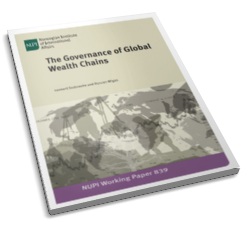Norwegian Institute of International Affairs • The Governance of Global Wealth Chains • 2014

Leonard Seabrooke and Duncan Wigan
This working paper creates a theoretical framework to explain how Global Wealth Chains are created, maintained, and governed. We draw upon different strands of literature, including scholarship in international political economy and economic geography on Global Value Chains, literature on finance and law in institutional economics, and work from economic sociology on network dynamics within markets. This scholarship assists us in highlighting three variables in how Global Wealth Chains are articulated and change according to: (1) the complexity of transactions, (2) regulatory liability and (3) innovation capacities among suppliers of products used in wealth chains. We then differentiate five types of global value chain governance – market, modular, relational, captive, and hierarchy – which range from simple ‘off shelf’ products shielded from regulators by advantageous international tax laws to highly complex and flexible innovative financial products produced by large financial institutions and corporations. This paper highlights how Global Wealth Chains intersect with value chains and real economies, and provides three brief case studies on offshore shell companies, family property trusts, and global-scale corporate tax avoidance.
Descargue NUPI+WP-839-Seabrooke-Wigan


Deja una respuesta